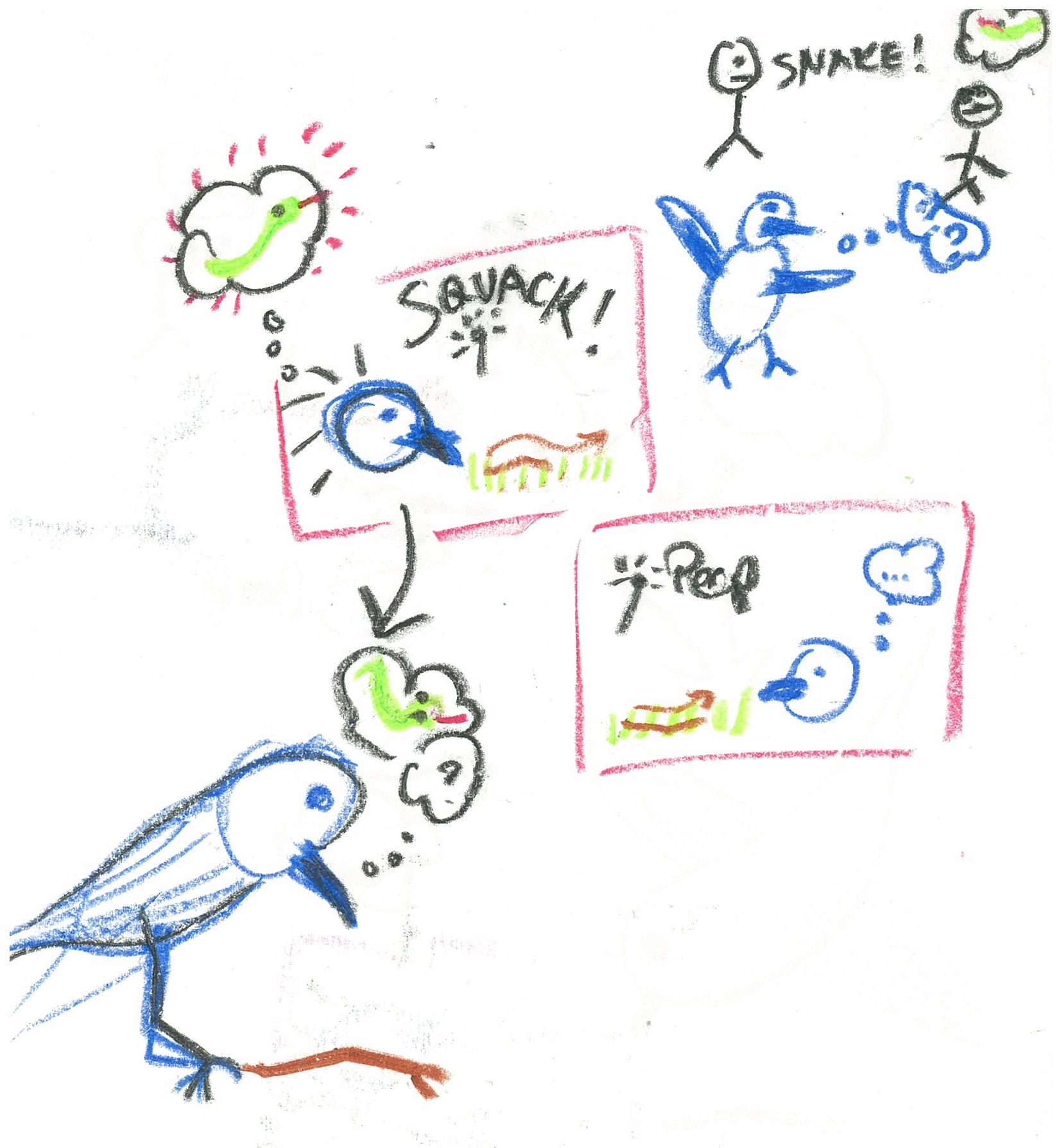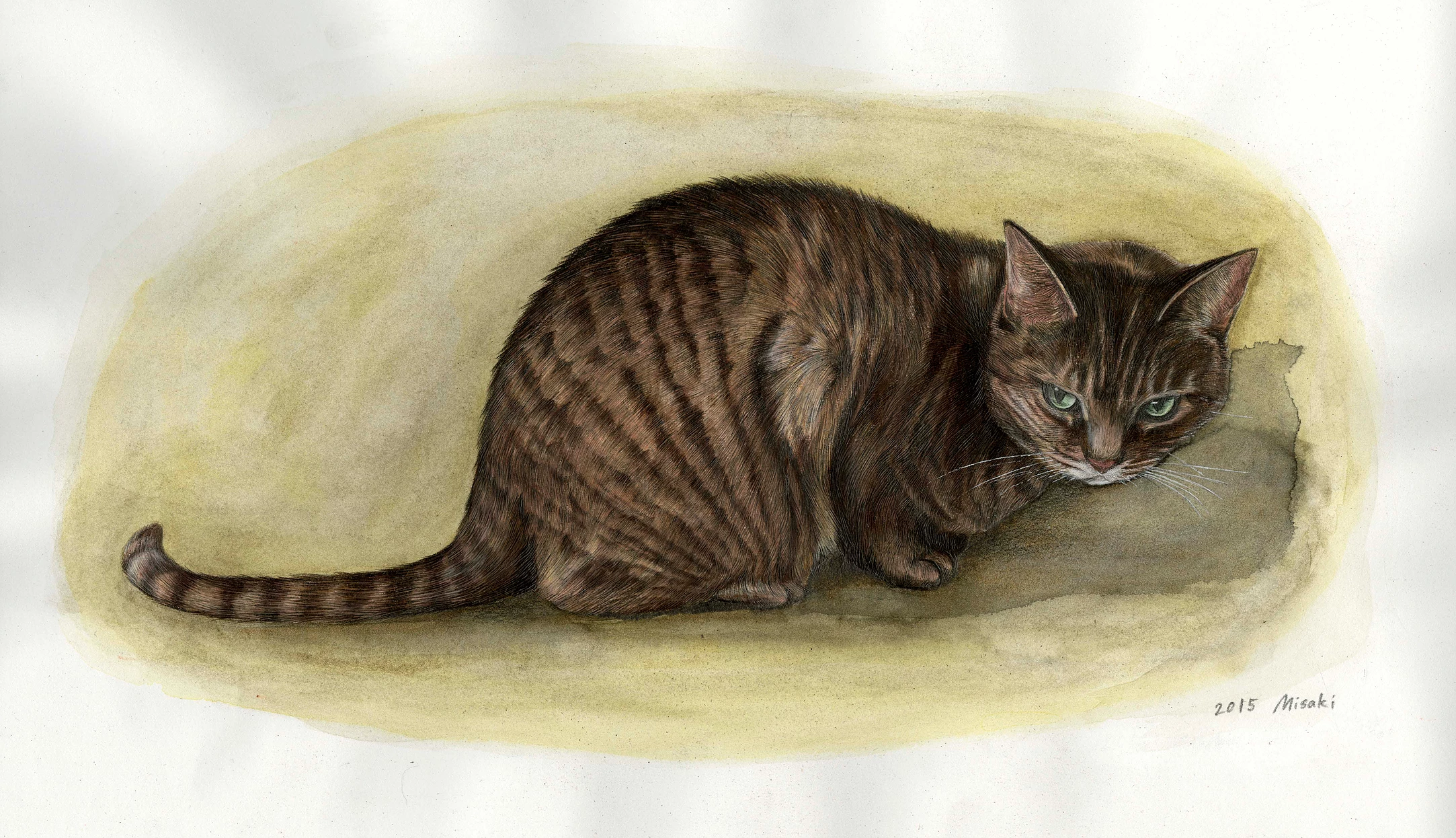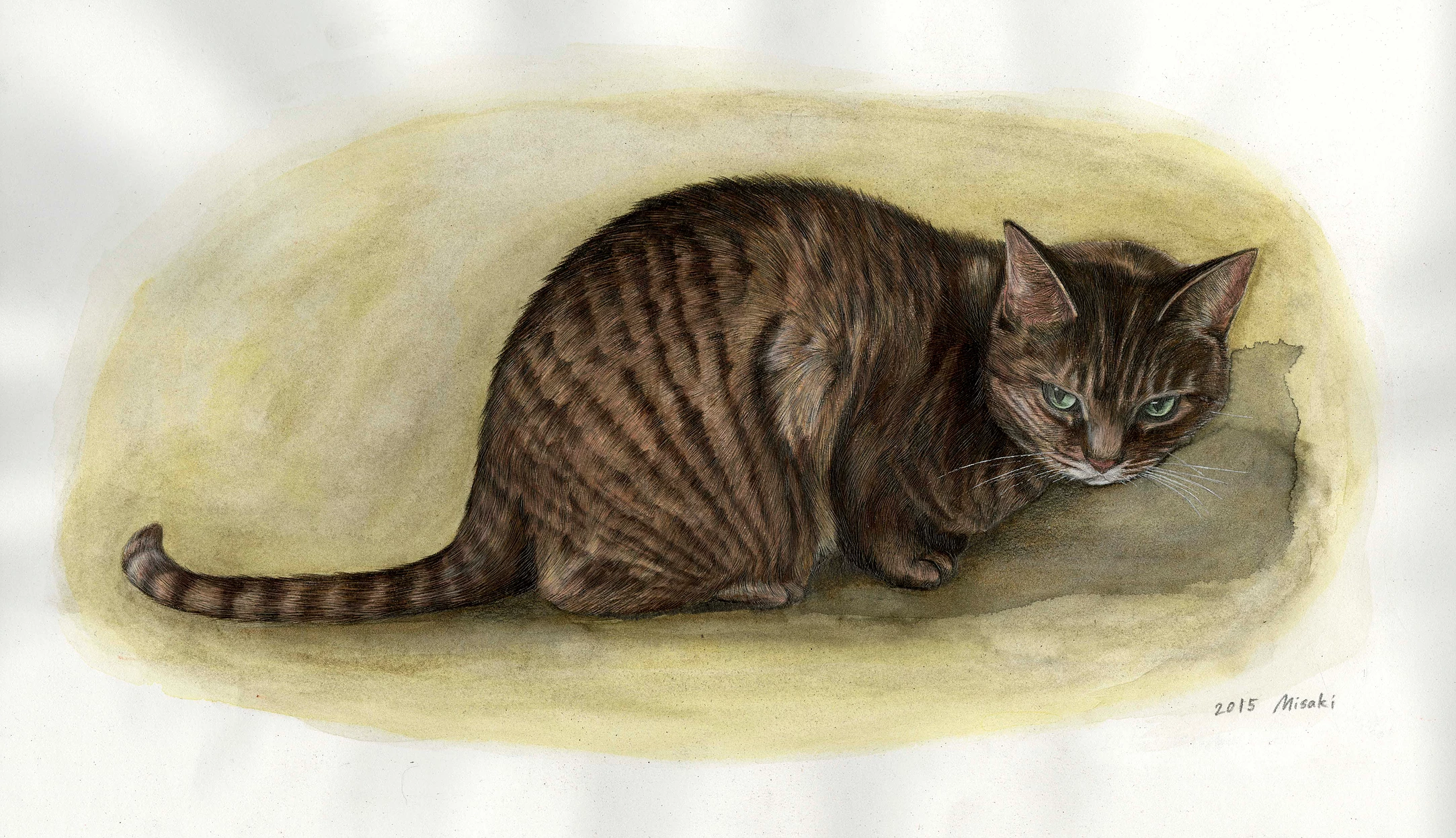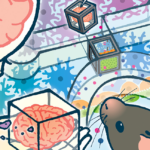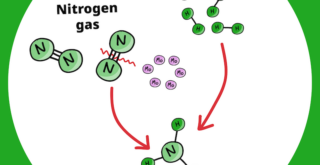This past May, I attended the 2nd annual Japan SciCom Forum (JSF) in Tokyo. I had been looking particularly forward to the science illustration workshop led by Misaki Ouchida, and it did not disappoint. Ouchida talked about graphical abstracts and her philosophy for making them. After some cool demonstrations, we split into groups and tried to draw our own graphical abstracts based off of press releases.
The idea was to be creative and scientifically accurate, choosing the proper key elements and placing them in the best configuration on the page. Needless to say, our amateur attempts were funny and I think everyone gained more respect for Ouchida’s talent as she casually drew amazing examples during the demonstration. Can I blame my sad attempt on the large diameter unsharpened crayons that I had to work with? Probably not.
After her workshop, Taka and I sat down to ask Ouchida about what she does and how she got to where she is.
This past May, I attended the 2nd annual Japan SciCom Forum (JSF) in Tokyo. I had been looking particularly forward to the science illustration workshop led by Misaki Ouchida, and it did not disappoint. Ouchida talked about graphical abstracts and her philosophy for making them. After some cool demonstrations, we split into groups and tried to draw our own graphical abstracts based off of press releases.
The idea was to be creative and scientifically accurate, choosing the proper key elements and placing them in the best configuration on the page. Needless to say, our amateur attempts were funny and I think everyone gained more respect for Ouchida’s talent as she casually drew amazing examples during the demonstration. Can I blame my sad attempt on the large diameter unsharpened crayons that I had to work with? Probably not.
After her workshop, Taka and I sat down to ask Ouchida about what she does and how she got to where she is.
About Misaki Ouchida
Before reading the Q & A below, here is some contextual information that will make it easier to understand. In 2012, Ouchida earned a PhD in particle physics (!!) from Hiroshima University in Japan. After graduating, she totally switched gears and earned an MA in anthropology from the University of Washington in the US. At the same time, she completed a certificate in Natural Science Illustration, also from the University of Washington. After graduating (again!), she worked as a scientific illustrator at the Cornell Lab of Ornithology in NY and then at the Smithsonian National Museum of Natural History in Washington, D.C. In 2016, she moved back to Japan to work as a science communicator and illustrator at the Center for iPS Cell Research and Application (CiRA) at Kyoto University. She can also be found teaching science illustration at Seian University. A full bio can be found here on her website.
Q & A
First, let’s talk a little about your art and training. Do you have your own style of illustrating that you incorporate into each job that you do, or do you adjust your style to match what people want?
Since I don’t have a strong artistic ego, I can always modify my style according to the audience. But the science comes first. Whatever I draw needs to be scientifically accurate. Remember, the whole point is to explain the science through illustration. I am comfortable drawing detailed anatomy, diagrams for papers, and even cartoons. It all depends on the purpose of the illustration.
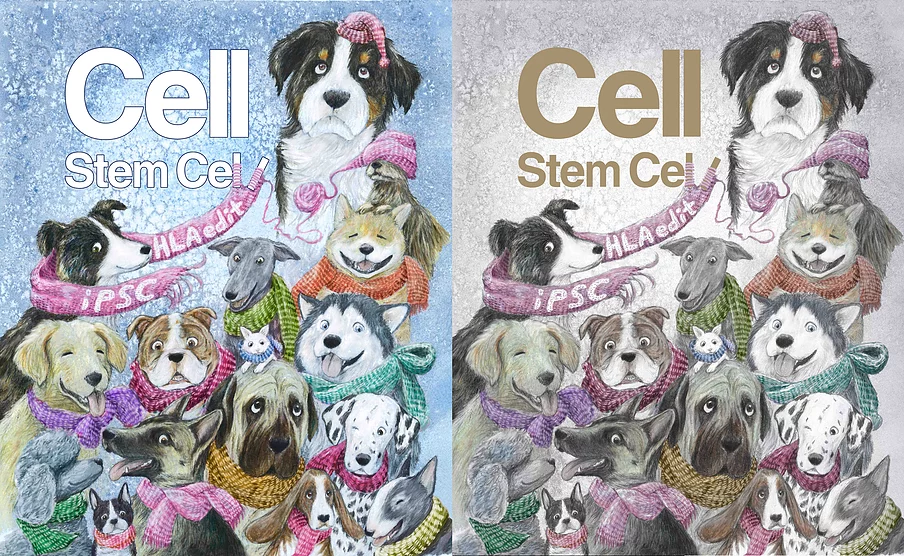
Cover for Cell Stem Cell. Left version was what the journal finally accepted, right version is what Ouchida prefers. You can read about the whole process on her website and learn about induced pluripotent stem cells (iPS cells). It’s very cool. © Misaki Ouchida
You have had illustrations accepted as the covers for Cell and Cell Stem Cell. That’s really quite an achievement! How did those opportunities come about?
Thank you. For the cover of Cell Stem Cell, I tried to show individual diversity by using many types of dogs. Knitting was the metaphor for gene editing (CRISPR), and the transformation of bad-fitting hats to a few different scarves that all dogs could wear represents the results of the study: the gene edited cells became immunologically compatible with host cells (they fit). One of the authors approached me to do this. But for the previous cover [Cell, not shown here], I asked the authors to participate in the competition because I was working on the press release for their paper. We received an e-mail from the editor saying that cover art was welcome, so I pushed the authors.
When you were working at the Cornell Lab of Ornithology, you drew outstanding illustrations of birds. Did you use real birds as models?
Cornell’s Ornithology Institute owns a huge number of specimens. Of course specimens aren’t alive, but we were able to examine them very closely. For example, I could study feather structure by touching them with my own hands. So, I could reflect what I had observed in my illustrations. I also had the chance to dissect birds once a week, which was extremely helpful. Many samples are sent to the lab every day, and somebody had to stuff them and make them into specimens. I volunteered to help make them and was able to teach myself bird anatomy, especially how muscles are built. I’m sure the knowledge I gained there was useful for making my illustrations more realistic.
Illustrating muscles sounds like a special skill. What else did you do to learn how to draw them?
Before working in the Ornithology Lab, I had the opportunity to study anatomy when I was in grad school getting my MA in anthropology. It was not part of my program, but I was still able to take an anatomy course at the University on my own initiative. I was attracted by Netter’s textbook on anatomy. I couldn’t buy it for myself because it was so expensive, so I decided to reproduce all the illustrations in the book. By drawing instead of taking photos, I was able to memorize the names of muscles and how they are organized. This activity helped me a lot later. I also had the chance to watch medical students as they trained for doing autopsies, which gave me an even higher level of understanding.

Reconstruction of Didelphodon vorax, one of the largest North American mammals of the Late Cretaceous period. The illustration is based on the fossil record and the skulls of similar extant mammals. You can read about the process for making this illustration and about the study on Ouchida’s website. © Misaki Ouchida
Looking at all your illustrations, it’s really amazing that you can do both very realistic illustrations as well as cartoons. Where did you learn how to draw?
Well, I took the certificate class for a year, but mostly I’m self-taught. I love manga and anime! Simply put, for detailed work, I just copy what I see. But actually, in my opinion, being too realistic is not a great quality for science illustration. Basically, if that’s what you want, you can use photos. On the other hand, there are many things that only illustrations can show, for example the reconstruction of an extinct species. Illustrations have power. We can use exhibitions at museums as models, as well as extant animals that are thought to be close to those that are extinct.
How do you approach the science illustration process?
Most of the time my illustrations are related to scientific papers. So first I read through the paper. In particular, I try to figure out which parts are scientifically important, and then I can focus my attention on drawing that.
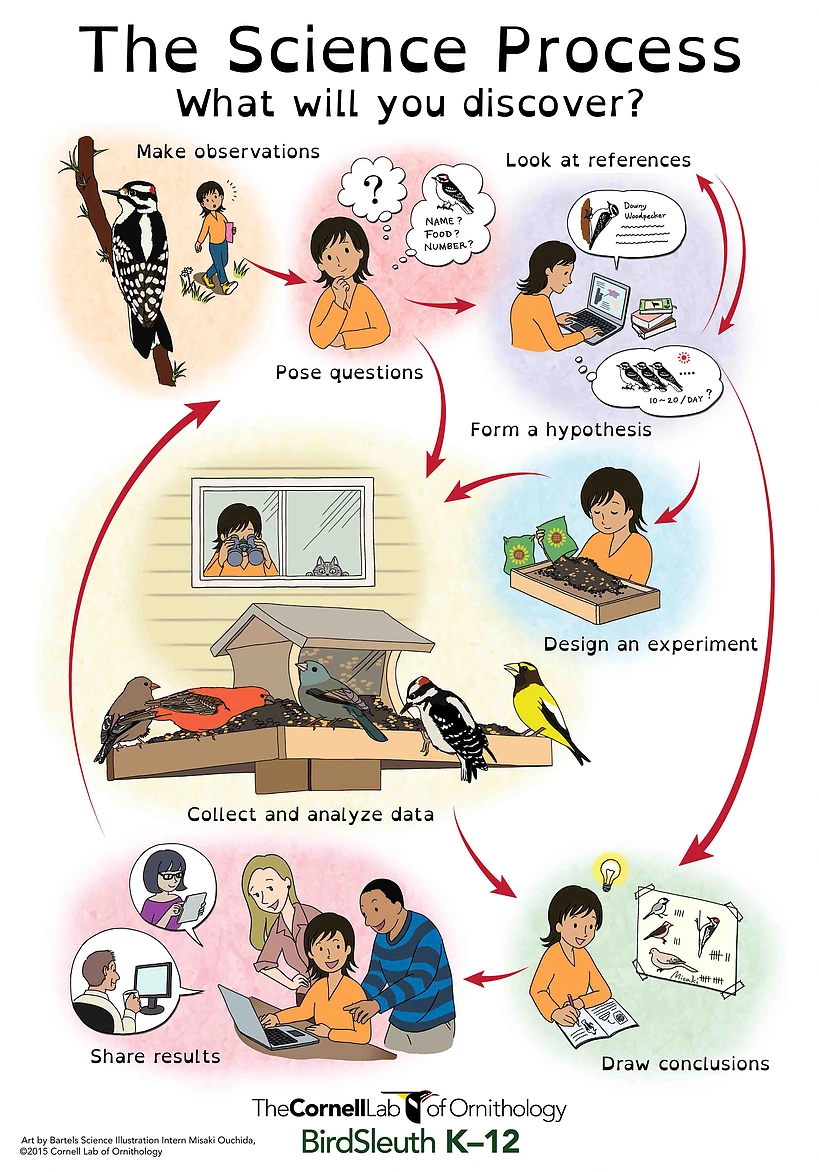
The Scientific Process Diagram © Misaki Ouchida. A realistic (non-linear) depiction of the scientific method.
Let’s talk about science illustration as a career. Do you think that having PhD is advantageous for your current work?
Generally speaking, you need to publish papers to obtain a PhD. Since I have experienced the process of writing papers as an author, when I work with researchers I can understand what to do and what stage of the process we are in. Because I have a strong science background, I can also advise researchers about how we can be more appealing to journal editors. Also, I can read papers from the draft stage and understand the contents more quickly than people without a science background. In that sense, having a PhD is a great advantage. At the same time, I don’t think a PhD is absolutely necessary. In my case, I wasn’t thinking about becoming a science illustrator when I began grad school in the US.
You’ve changed career paths twice, from physics to anthropology, and then from research to illustration. How did you make the decision to plunge into illustration as a full-time career?
I struggled to make that decision, of course. But my supervisor at the University of Washington pushed me. She said, “chase the tennis ball,” like a dog… there’s no logical reason for that behavior. A dog wants to chase the ball. This kind of passion is necessary, and I realized I had that passion and I wanted to chase the ball. Without her advice, I might have chosen a different career.
Why did you decide to study in the United States?
After I got my PhD in particle physics, I became interested in anthropology. As I’m a natural scientist at heart, I wanted to study physical (biological) anthropology, which approaches anthropology from a natural science perspective that includes physiology and behavioral science. Unfortunately, 10 years ago when I was searching for a program in Japan, anthropology was always considered part of the social sciences. Luckily, I found the excellent physical anthropology program at the University of Washington, and was accepted when I applied.
Do you have favorite illustrations?
Aside from the Cell Stem Cell cover, I also like this illustration I did of my housemate at Cornell. ✅
Q & A
First, let’s talk a little about your art and training. Do you have your own style of illustrating that you incorporate into each job that you do, or do you adjust your style to match what people want?
Since I don’t have a strong artistic ego, I can always modify my style according to audience. But the science comes first. Whatever I draw needs to be scientifically accurate. Remember, the whole point is to explain the science through illustration. I am comfortable drawing detailed anatomy, diagrams for papers, and even cartoons. It all depends on the purpose of the illustration.
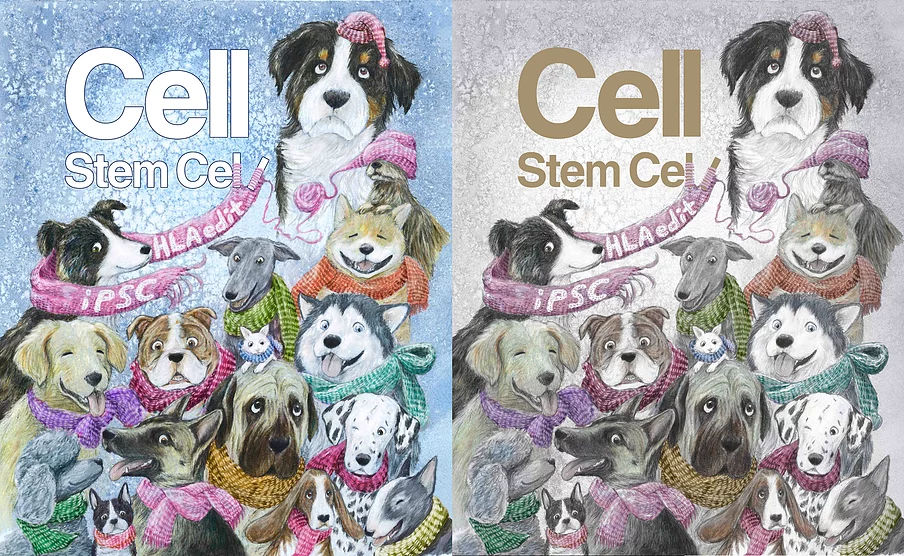
Cover for Cell Stem Cell. Left version was what the journal finally accepted, right version is what Ouchida prefers. You can read about the whole process on her website and learn about induced pluripotent stem cells (iPS cells). It’s very cool. © Misaki Ouchida
You have had illustrations accepted as the cover for Cell and Cell Stem Cell. That’s really quite an achievement! How did those opportunities come about?
Thank you. For the cover of Cell Stem Cell, I tried to show individual diversity by using many types of dogs. Knitting was the metaphor for gene editing (CRISPR), and the transformation of bad-fitting hats to a few different scarves that all dogs could wear represents the results of the study: the gene edited cells became immunologically compatible with host cells (they fit). One of the authors approached me to do this. But for the previous cover [Cell, not shown here], I asked the authors to participate in the competition because I was working on the press release for their paper. We received an e-mail from the editor saying that cover art was welcome, so I pushed the authors.
When you were working at the Cornell Lab of Ornithology, you drew outstanding illustrations of birds. Did you use real birds as models?
Cornell’s Ornithology Institute owns a huge number of specimens. Of course specimens aren’t alive, but we were able to examine them very closely. For example, I could study feather structure by touching them with my own hands. So, I could reflect what I had observed in my illustrations. I also had the chance to dissect birds once a week, which was extremely helpful. Many samples are sent to the lab every day, and somebody had to stuff them and make them into specimens. I volunteered to help make them and was able to teach myself bird anatomy, especially how muscles are built. I’m sure the knowledge I gained there was useful for making my illustrations more realistic.
Illustrating muscles sounds like a special skill. What else did you do to learn how to draw them?
Before working in the Ornithology Lab, I had the opportunity to study anatomy when I was in grad school getting my MA in anthropology. It was not part of my program, but I was still able to take an anatomy course at the University on my own initiative. I was attracted by Netter’s textbook on anatomy. I couldn’t buy it for myself because it was so expensive, so I decided to reproduce all the illustrations in the book. By drawing instead of taking photos, I was able to memorize the names of muscles and how they are organized. This activity helped me a lot later. I also had the chance to watch medical students as they trained for doing autopsies, which gave me an even higher level of understanding.
Looking at all your illustrations, it’s really amazing that you can do both very realistic illustrations as well as cartoons. Where did you learn how to draw?
Well, I took the certificate class for a year, but mostly I’m self-taught. I love manga and anime! Simply put, for detailed work, I just copy what I see. But actually, in my opinion, being too realistic is not a great quality for science illustration. Basically, if that’s what you want, you can use photos. On the other hand, there are many things that only illustrations can show, for example the reconstruction of an extinct species. Illustrations have power. We can use exhibitions at museums as models, as well as extant animals that are thought to be close to those that are extinct.
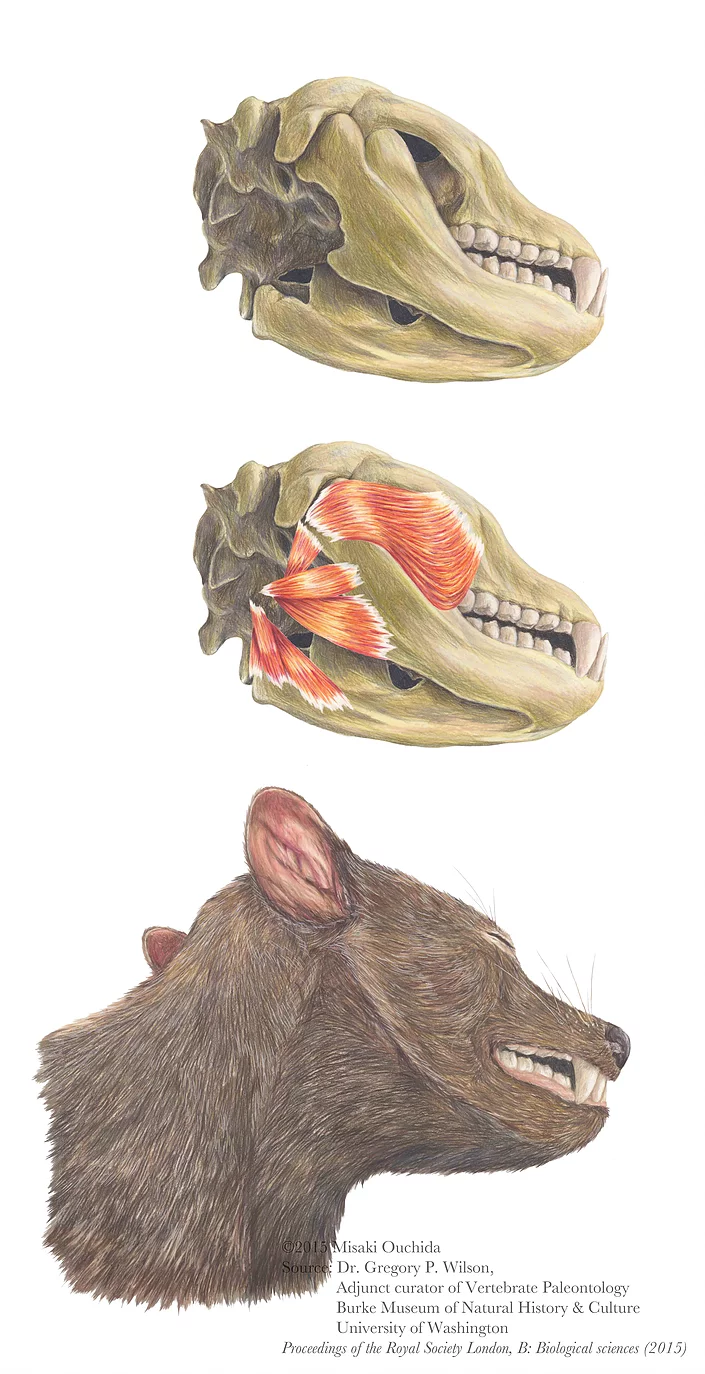
Reconstruction of Didelphodon vorax, one of the largest North American mammals of the Late Cretaceous period. The illustration is based on the fossil record and the skulls of similar extant mammals. You can read about the process for making this illustration and about the study on Ouchida’s website. © Misaki Ouchida
How do you approach the science illustration process?
Most of the time my illustrations are related to scientific papers. So first I read through the paper. In particular, I try to figure out which parts are scientifically important, and then I can focus my attention on drawing that.
Let’s talk about science illustration as a career. Do you think that having PhD is advantageous for your current work?
Generally speaking, you need to publish papers to obtain a PhD. Since I have experienced the process of writing papers as an author, when I work with researchers I can understand what to do and what stage of the process we are in. Because I have a strong science background, I can also advise researchers about how we can be more appealing to journal editors. Also, I can read papers from the draft stage and understand the contents more quickly than people without a science background. In that sense, having a PhD is a great advantage. At the same time, I don’t think a PhD is absolutely necessary. In my case, I wasn’t thinking about becoming a science illustrator when I began grad school in the US.
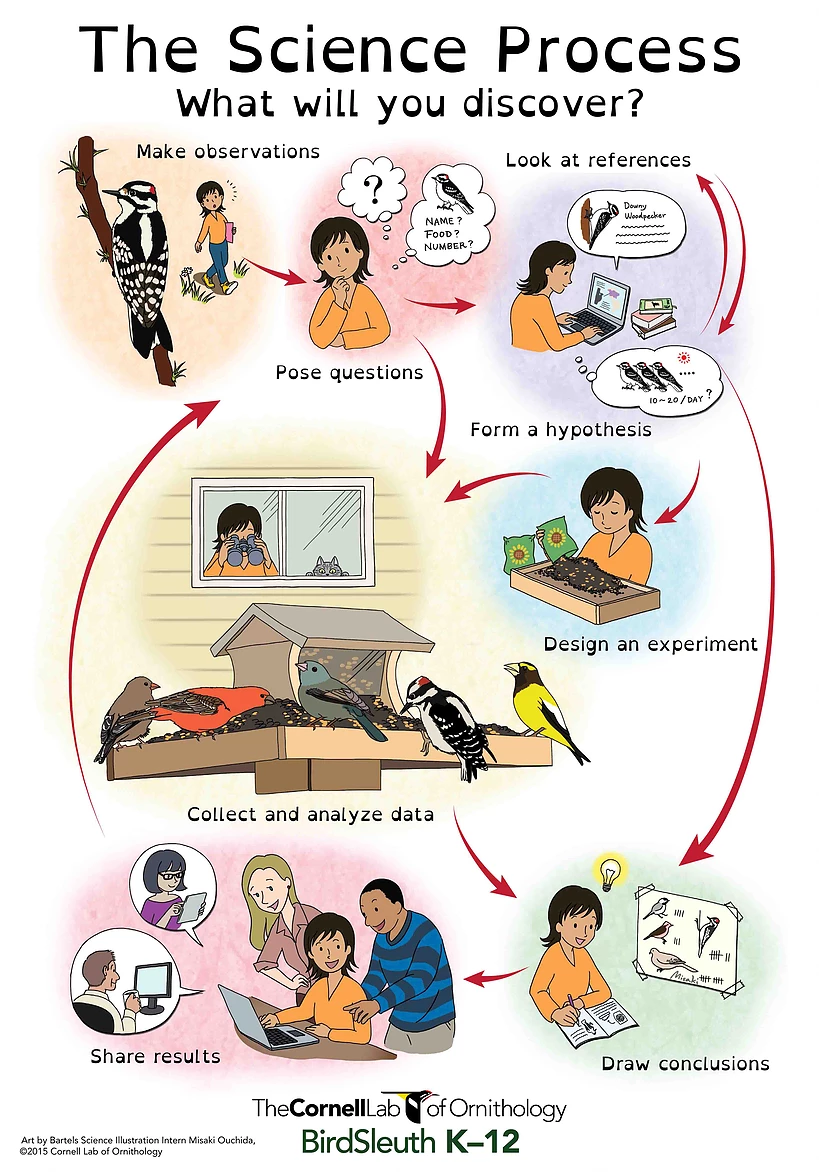
The Scientific Process Diagram © Misaki Ouchida. A realistic (non-linear) depiction of the scientific method.
You’ve changed career paths twice, from physics to anthropology, and then from research to illustration. How did you make the decision to plunge into illustration as a full-time career?
I struggled to make that decision, of course. But my supervisor at the University of Washington pushed me. She said, “chase the tennis ball,” like a dog… there’s no logical reason for that behavior. A dog wants to chase the ball. This kind of passion is necessary, and I realized I had that passion and I wanted to chase the ball. Without her advice, I might have chosen a different career.
Why did you decide to study in the United States?
After I got my PhD in particle physics, I became interested in anthropology. As I’m a natural scientist at heart, I wanted to study physical (biological) anthropology, which approaches anthropology from a natural science perspective that includes physiology and behavioral science. Unfortunately, 10 years ago when I was searching for a program in Japan, anthropology was always considered part of the social sciences. Luckily, I found the excellent physical anthropology program at the University of Washington, and was accepted when I applied.
Do you have favorite illustrations?
Aside from the Cell Stem Cell cover, I also like this illustration I did of my housemate at Cornell. ✅



